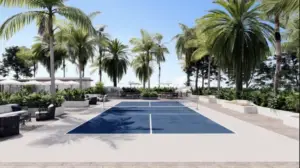The pickleball dink shot is part of every great players arsenal. Those that have done it successfully know the sweet sound of the paddle lightly kissing the ball and sending it on a rapid descent into the opposite court. Sounds great right? Well, like most skill that can seriously level up your game, it takes a bit of finesse to perfect.
Pickleball Dink Shot
A dink shot is a soft hit with a downward motion that places the ball in the opponents non-volley zone. Hitting a dink shot requires precise placement, control of your paddle, and legal positioning when making contact with the ball

The basics of a pickleball Dink shot
For starters let’s break down what exactly a dink shot is. Like the name implies, it is a light touch that directs the ball into a fast path towards the ground. While any shot that that meets that requirement could be considered a dink, the key to making it effective is landing it in the opposing no-volley zone (or kitchen).
It’s also worth noting a dink shot cannot occur until after the second hit of the rally. Dinks are always hit as a volley meaning the ball can’t bounce. The first hit (the serve) and the second hit (the return) must bounce before the opposing team can hit the ball. Once the third hit rolls around and volleys are allowed, you can start thinking about landing a dink.
The dink shot is part of what makes the game fun and accessible for all ages. Since it relies on body positioning rather than strength, it allows people of all ages and athletic abilities to execute contributing to the populatiry and fun nature of the sport.
Pickleball strategy: When to hit a dink shot
Besides waiting for the point in the rally when you can legally go for a dink, it’s not always the right move. The third shot in pickleball rallies is a crucial moment, and sometimes, a drive is a better option. In order to hit a dink, you want to be up close to your own no-volley line in order to properly place the shot.
You also want to assess where your opponent’s position. If they are close to the center line, sometimes it’s easier to drive the ball down the left or right side of the court towards the baseline taking advantage of the open space.
With that said, a dink shot is often the right move catch your opponent off guard.
How to hit a dink shot in pickleball
When the right moment presents itself in a rally, there are four steps to hit a pickleball dink shot: positioning, striking the ball, placing the ball, and timing your hit. Getting each part right is essential to increasing your chance that your opponent will not be able to return the hit.
Player positioning
For starters, your hit needs to be legal. The biggest mistake players make is stepping into the no-volley zone when they attempt a dink. Since a dink shot requires you to be playing at the no-volley line, players can get over zealous step into the zone as they hit. Rookie mistake!
Nailing the shot starts with making the shot legal, so watch your feet as you hit. The pickleball kitchen rules can be a bit nuanced, so it’s worth a refresh before you try to master the dink.
Striking the ball
This is the most important part of perfecting the dink. Contact the ball in front of your body with the paddle face open and use a gentle lifting motion. Keep the shot soft and controlled, using movement from the shoulder — don’t use wrist or backswing! This will stop the ball from launching past your intended target, keep it low, and land within the non-volley zone.
Placing the ball
We’ve mentioned the no-volley zone a couple of times, and yes that’s where you want the ball to land. But the specifics are a bit more nuanced. As a general rule, the closer you can get the ball to the net, the better. It forces the opponent to get low and hit a soft shot upwards, setting you up for an easy put-away.
The other tip is dink the ball cross court. Remember the a pickleball net height is lower in the middle — that means you can get the ball slightly closer to the ground is it crosses the court there. In a game as precise as pickleball, sometimes a couple inches makes all the difference.
Timing your dink shot
Finally, dinks aren’t a one a done deal. The greatest pickleball rallies are usually made up of a series of dink shots. If you don’t score on your first one, try again! After a few back and forths, your opponent might get out of position and open up opportunity for a drive shot. Changing up your game and using the dink shot strategically is the best way to keep it effective.
Wrap up: Doing the dink
Mastering the dink shot can take you from being a scrub to a pickleball master. Play around with these tips until you have it down. We’ll see ya out there.

Spencer is writer and website owner from California. He started playing pickleball with his pops and they have a running tally of matches won and lost. Spencer declines comment on where the record stands.








